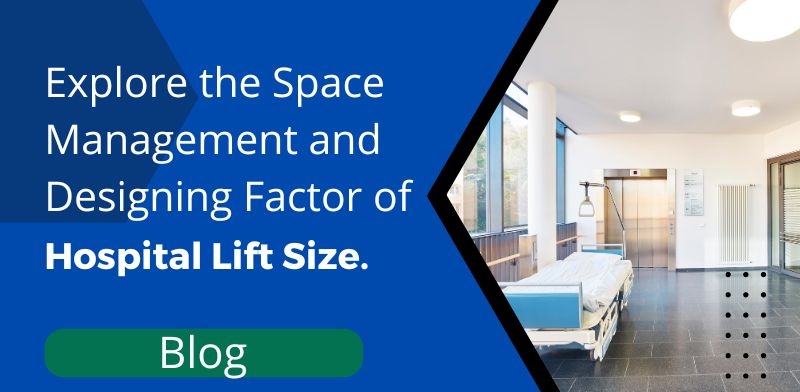Patients in critical condition are transported from one level of a hospital to another using the hospital lift, sometimes referred to as the stretcher lift. These lifts transport hospital employees, medical equipment and other essential objects in addition to lifting patients on stretchers. Additionally, hospitals have unique needs, including big and sturdy vehicles, pleasant travel, precise stops with inch-up and inch-down push buttons on the car, emergency control capabilities, and most importantly, dependability and safety. The vehicle is designed to meet Indian Standard specifications for hospital elevators. Let’s learn about the hospital lift size that gives patients comfortable and hassle-free vertical lifting.
What are key conditions depending on hospital lift size?
The size of the hospital lift should meet requirements for at least one stretcher and one companion. Hospital lift cabs should adhere to sanitary standards for health reasons, and efforts should be made to avoid the growth of bacteria.
When designing a lift for a hospital, one of the most important considerations is that it should be jerk-free. In this manner, it is possible to avoid upsetting a patient who is strapped to a stretcher or seated in a wheelchair and equipped with a life support system or other devices. Stretchers, along with other patients, nurses, and medical personnel, should be able to be easily moved in the elevators.
For patient convenience, hospital lifts often come with centre-opening Telescopic Power Operated Doors. These devices, which are specially made for hospital use, enable adequate transportation of bulky stretchers and hospital beds. This elevator should be well-regarded for its durable design, outstanding resistance to corrosion and wear, and simple maintenance requirements.
Hospital lifts also referred to as patient lifts, are decorated inside with stainless steel, and the illumination is regulated at a level that does not bother the patient. Hospital lift doors are broader than those of other types of lifts, and their cabin buttons are located lower than those of different types of lifts. Any time there is a power outage, precautions should be taken.
The basic dimension of hospital lift
- The hospital lift dimension is generally 1600 mm-5200 mm. A car height of 2.2 metres was used to compute the overall headroom.
- In the case of manually operated doors, the amount of handle projection on the landing door will restrict the clear entrance.
- Even though a lift with a 15-person capacity is not typical, it is included to include lifts with lesser capacities that can be utilized in smaller hospitals.
- The capacity carrying weight from 1600–2000 kg and their various speeds of 0,40–30 m/s, hospital lifts may be selected.
Conclusion
Nursing homes, clinics and other healthcare facilities generally use hospital elevators. This is the best option for safely moving patients, patient beds, medical equipment, and all key medical personnel to use hospital elevators. If you need a jark-free, well-equipped and safe healthcare elevator, it is important to hire an experienced and professional manufacturer to get the best lift and services. A well-planned lift size can positively impact patient flow, decrease wait times, and contribute to an overall improved hospital experience.
